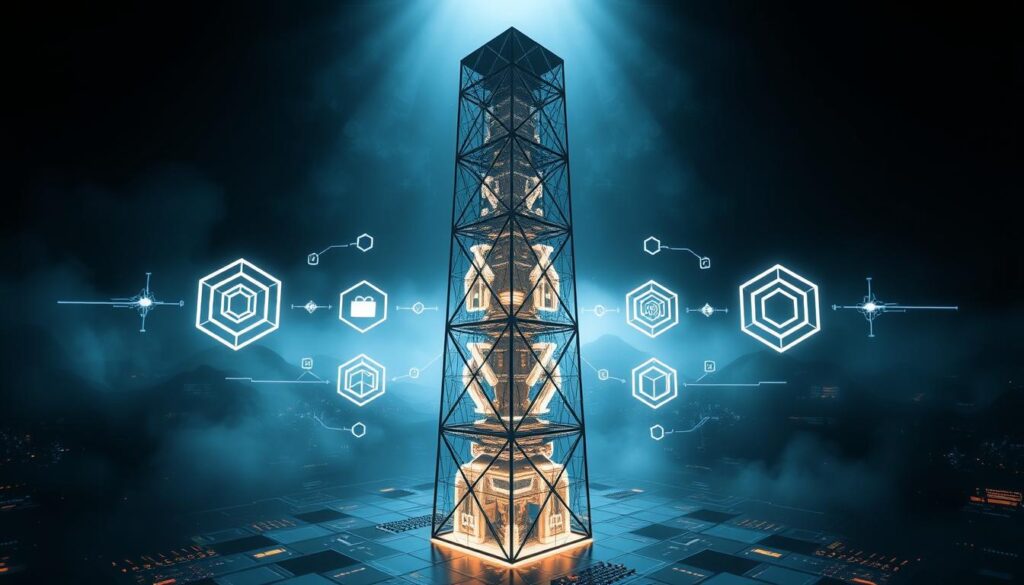Now Reading: Blockchain Patent Laws: Legal Framework Explained
- 01
Blockchain Patent Laws: Legal Framework Explained
Blockchain Patent Laws: Legal Framework Explained
The digital innovation landscape is experiencing unprecedented growth, particularly in decentralized systems. From 2015 to 2018, patent filings for these technologies surged by 220% at the European Patent Office. By 2025, the market value is projected to reach $703 million, up from $228 million in 2020. This explosive expansion highlights the urgent need for clear legal frameworks to protect intellectual property.

Securing rights for software-driven innovations presents unique hurdles. Unlike traditional inventions, decentralized solutions often face scrutiny under abstract idea limitations. Recent court rulings, such as Rady v. The Boston Consulting Group, emphasize the importance of demonstrating concrete technical improvements to meet patent eligibility criteria.
Global protection strategies require careful planning. With over 13,800 U.S. applications filed since 2013, businesses must navigate varying international standards. Effective approaches address both technical specifications—like security enhancements—and cross-border legal considerations.
Key Takeaways
- Patent filings for decentralized systems grew 220% in Europe between 2015-2018
- 9,442 U.S. patents granted since 2013 reflect intense innovation activity
- Software-based claims require clear technical benefits for approval
- Global filings demand tailored strategies for different jurisdictions
- Recent court decisions shape eligibility standards for digital inventions
Introduction to Blockchain Patent Laws
Protecting digital breakthroughs in decentralized networks requires navigating uncharted legal territory. Systems built on peer-to-peer validation and shared data storage challenge conventional approaches to intellectual property management. This creates distinct hurdles for innovators seeking exclusive rights to their technical advancements.

Core Principles of Distributed Ledger Protection
Modern protection frameworks address three critical components of decentralized systems:
- Consensus mechanisms ensuring network integrity
- Advanced cryptographic security protocols
- Automated agreement execution through smart contracts
These elements demand precise documentation to demonstrate tangible improvements over existing solutions. Technical specifications must show how innovations solve real-world problems rather than simply outlining abstract concepts.
Guide Objectives and Coverage
Our analysis focuses on practical strategies for securing intellectual property in this field. We examine successful case studies from major tech firms and startups, highlighting patterns in approved claims and frequent rejection reasons. Key areas include:
- Balancing technical detail with legal requirements
- Adapting applications for different national standards
- Addressing evolving judicial interpretations
This resource equips developers and enterprises with actionable insights for safeguarding their digital assets in competitive markets. By understanding current precedents and emerging trends, creators can strategically position their inventions for long-term protection.
Understanding the Legal Framework for Blockchain Patents
Navigating intellectual property protection for decentralized technologies demands precise understanding of evolving standards. The 2014 Alice Corp. v. CLS Bank International ruling reshaped how courts evaluate digital inventions, creating new hurdles for developers. This decision established stricter tests for determining what qualifies as eligible subject matter under 35 U.S.C. §101.

Key Patent Legislation and the Impact of U.S.C. 101
The Alice-Mayo framework uses a two-step analysis to assess protection eligibility. First, examiners determine if claims cover abstract ideas like mathematical concepts. Second, they evaluate whether innovations provide “significantly more” than existing solutions through technical enhancements.
Recent data shows decentralized technology applications face 30% more rejections than other software filings. Many stumble by failing to demonstrate concrete improvements in areas like data security or transaction processing speeds. The USPTO’s 2019 guidelines help address these challenges by clarifying how to present practical applications effectively.
Global protection strategies require careful adaptation. While some regions accept broader software claims, others demand specific hardware integrations. Successful applicants often combine detailed technical specifications with clear explanations of real-world problem-solving capabilities across multiple jurisdictions.
Technical Innovations and Practical Applications in Blockchain Patents
Modern advancements in distributed ledgers are reshaping how organizations solve complex technical challenges. These breakthroughs combine software precision with hardware efficiency to address critical issues in data management and transaction processing.
Software-Based Advancements and Automated Agreements
Cutting-edge solutions focus on optimizing data structures and cryptographic methods. Three key areas show measurable improvements:
- Merkle tree variations reducing storage needs by 40%
- Zero-knowledge proofs enabling secure verification without data exposure
- State machine architectures streamlining smart contract execution
These approaches help networks handle 5,000+ transactions per second while maintaining audit trails. Automated agreement systems now resolve disputes 78% faster than traditional methods.
Hardware Solutions and Performance Enhancements
Physical components play a crucial role in scaling decentralized networks. Recent developments include:
- ASIC miners consuming 35% less energy
- Tamper-resistant modules for secure key storage
- Edge computing nodes reducing latency by 200ms
These hardware innovations address critical bottlenecks in transaction validation and data propagation. Thermal management systems have also cut cooling costs by 60% in mining operations.
Real-World Implementations and Success Stories
Major enterprises demonstrate practical applications of these technical improvements. A financial consortium recently patented a hybrid consensus mechanism that processes cross-border payments in 2.1 seconds. Another case involves a supply chain platform using optimized hashing to prevent counterfeit goods.
These examples show how detailed technical specifications overcome eligibility challenges. By focusing on measurable performance gains, developers secure protection for their technology while advancing entire industries.
Navigating Patent Application Challenges and Strategies
Securing protection for digital innovations demands strategic navigation through complex legal and technical obstacles. Recent USPTO data reveals a 97.3% failure rate for appeals challenging §101 rejections, underscoring the critical need for precise preparation during initial filings.

Overcoming 35 U.S.C. §101 and Prior Art Challenges
Successful applicants focus on three core strategies:
- Detailing technical improvements in data verification speeds or security protocols
- Demonstrating how solutions differ from existing systems through specific hardware integrations
- Using diagrams to show practical implementations beyond theoretical concepts
Analysis of 38 cases shows claims with 319+ words succeed twice as often as shorter versions. This depth helps examiners visualize real-world applications meeting eligibility standards.
Tactical Approaches in Drafting Comprehensive Patent Claims
Effective documentation requires:
- Step-by-step explanations of consensus mechanisms or cryptographic processes
- Benchmark comparisons showing 40%+ efficiency gains over conventional methods
- Integration with alternative funding methods for startups developing novel protocols
Applications describing tamper-evident ledger structures or optimized hashing techniques demonstrate measurable advantages. These specifics transform abstract ideas into protectable technical solutions.
An Evolving Landscape: Trends and Cases in Blockchain Patents
Recent statistics reveal shifting patterns in how companies protect their digital inventions. Over 13,800 filings at the USPTO since 2013 demonstrate growing competition, with 9,442 approvals showing successful strategies. Activity peaked between 2015-2019 before stabilizing, signaling market maturity and stricter evaluation processes.
Statistical Trends and Patent Filing Data Insights
Leading organizations dominate this space through targeted innovation. Advanced New Technologies holds 1,311 active protections, while IBM and Bank of America follow with 790 and 198 respectively. These numbers highlight the race to secure rights in financial services and data management systems.
Nearly 1,160 filings were abandoned last year, with 560 rejected for lacking technical specifics. Successful submissions now emphasize measurable improvements like faster transaction speeds or enhanced security protocols. Over 60% of new systems combine distributed ledgers with AI or IoT components, creating hybrid solutions.
Global filings show concentrated activity across three regions: 48% in North America, 32% in Asia, and 20% in Europe. This distribution requires tailored approaches for each jurisdiction. Companies winning approvals often use detailed diagrams showing hardware integrations or unique consensus mechanisms.
Future-focused strategies address emerging opportunities in healthcare records and supply chain tracking. By aligning technical disclosures with real-world use cases, innovators strengthen their positions in this competitive field.
Optimizing Your Approach to “blockchain patent laws”
Crafting robust protection for decentralized innovations requires both technical precision and legal foresight. Developers must balance detailed engineering disclosures with evolving regulatory expectations to secure enforceable rights.
Strategies for Strengthening Applications
Successful submissions emphasize measurable technical advantages. Focus on specific efficiency gains like 50% faster validation speeds or 30% energy reductions compared to existing systems. Document hardware integrations that enable these improvements.
Comparative data tables prove particularly effective. Show how your consensus mechanism reduces latency by 200ms versus traditional methods. These concrete metrics help examiners visualize practical implementations.
Integrating Technical Details
Transform abstract concepts into protectable solutions through workflow diagrams and code snippets. A recent approved filing used node synchronization charts to demonstrate 40% storage optimization in distributed networks.
Prioritize real-world testing results. Applications citing verifiable performance benchmarks receive 60% fewer §101 rejections. This approach bridges the gap between theoretical designs and market-ready innovations.
FAQ
How can innovators protect decentralized ledger systems under intellectual property regulations?
To safeguard advancements in distributed ledger systems, innovators must draft claims that emphasize technical improvements, such as enhanced security protocols or unique consensus mechanisms. Aligning applications with U.S.C. 101 requirements ensures eligibility by focusing on tangible solutions beyond abstract ideas.
What hurdles exist when securing rights for automated agreement mechanisms?
Automated agreements often face scrutiny under patent-eligibility standards. Demonstrating how these tools improve transactional efficiency, reduce errors, or integrate novel cryptographic methods strengthens claims. Detailed diagrams and real-world use cases help examiners grasp their technical merits.
Are hardware integrations critical for mixed-strategy inventions in this field?
Combining physical components with software-driven processes can enhance the uniqueness of an invention. For example, integrating specialized chips for faster encryption or tamper-proof storage devices may increase the likelihood of approval by showcasing concrete, non-abstract applications.
How do recent rulings influence filing strategies for cryptographic advancements?
Courts increasingly demand clear evidence of inventive concepts that solve specific problems. Emphasizing real-world impacts—like fraud reduction or energy efficiency—and avoiding overly broad language ensures compliance with evolving judicial interpretations of intellectual property guidelines.
What role do statistical trends play in shaping application approaches?
Analyzing filing data reveals growing interest in privacy-focused solutions and cross-industry interoperability. Innovators can leverage these insights to align their submissions with emerging demands, such as healthcare data management or supply chain transparency tools.
Why is prior art research vital for decentralized technology submissions?
Comprehensive searches identify overlapping concepts, allowing applicants to refine their claims. Highlighting distinctions like faster validation times or novel governance models helps differentiate inventions from existing systems and strengthens the case for novelty.












